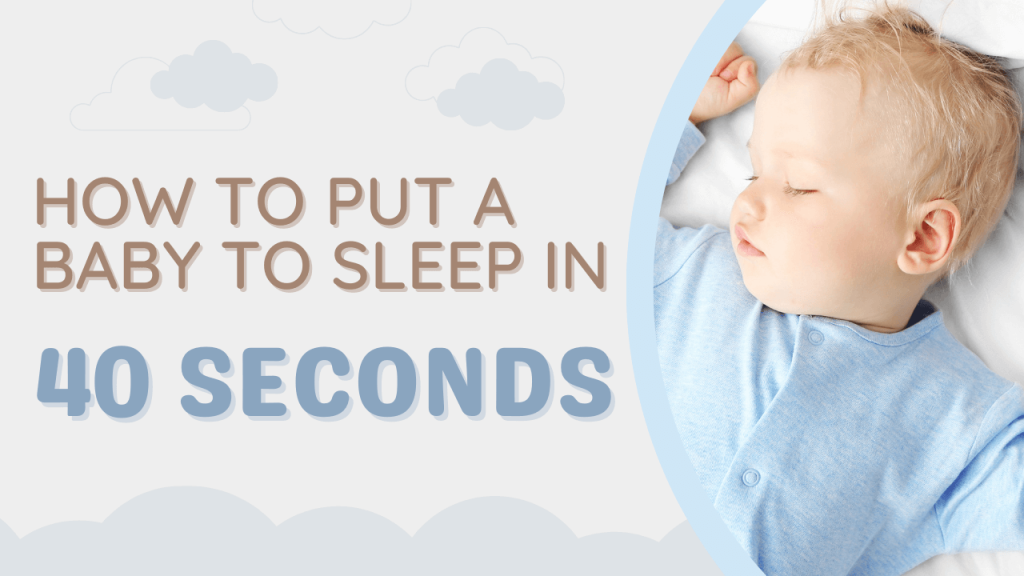
A baby’s first year of life is an important milestone in the life of babies as well as parents. Babies’ sleep differs from parents who are adults, so it can take a long time for parents to train for a new baby’s sleep routine and ensure their baby is getting a healthy fast amount of sleep. It’s really normal to have questions about how to put a baby to sleep in 40 seconds. In this article, I will show you the baby sleep cycle as well as some strategies to help you put your baby to sleep in just 40 seconds.
Understanding Baby Sleep Cycles
To be able to put your child to fall asleep quickly and effectively, you need to understand the sleep patterns and science of good night of baby sleep.
- From birth to 4 months old: most newborns sleep for 16-18 hours a day, throughout the daytime and nighttime. And they only wake up for feedings (usually every 2-3 hours). Newborns cannot distinguish between day and night, so they can only sleep a lot during the day and wake up at night. If your child sleeps about 8 hours during the day, he or she will sleep probably 9 hours at night. Their sleep pattern is also divided into short periods of 2-4 hours.
- Between 4 to 6 months of age: infants typically require 12 to 16 hours of sleep per day. During this period, their sleep patterns begin to consolidate into longer time as they can sleep longer without needing to feed.1 Most babies start sleeping through the night around this time, although exceptions exist.
- Between 6 to 12 months: the majority of a baby’s sleep occurs during nighttime hours. However, factors such as teething, growth spurts, illnesses, or sleep regressions may cause nighttime awakenings. Parents may consider implementing more targeted sleep-training approaches if their babies aren’t consistently sleeping through the night during this stage.
Although the baby’s sleeping cycle is different from that of an adult, they go through two different stages: non-REM (NREM) and REM sleep, REM is short for Rapid Eye Movement. And they spend nearly equal amounts of time in REM and NREM in their sleep. 2
You can understand REM is “active sleep”. In REM or “active sleep”, a baby’s eyes move around (while their eyes are closed) a baby will make some small movements such as twitching or jerking their limbs and fingers, speeding their breath or moving their mouths. And NREM can be understood as “quiet sleep.” While “quiet sleep” or NREM, the baby does not make these movements. 3
Therefore, during REM sleep, your baby can easily wake up, because they’re light asleep, so any noise or movement can interrupt their snooze anytime. In contrast, during the NREM stage, your baby’s in a deep and peaceful sleep and hardly wakes up.
Because newborns are not born with a strong biological clock, sleep training is not possible for most of them. Parents who want to sleep train have to understand their baby’s unique development timeline, and accept not to be able to sleep train until they are six months of age. So knowing a baby’s sleep cycle is important for parents who want sleep training for your babies.
Around three months of age, babies start having the same sleep stages as adults. These stages comprise four distinct sleep stages 4, including three non-REM (NREM) stages and one REM stage, each distinguished by the brain wave.
To put it simply, The first three stages are NREM, with the first two being lighter phases. In the initial two phrases, a person can easily wake up. While the third is the deepest stage, and this is a stage that is difficult to wake someone up. The fourth stage is REM, associated with dreaming. Though babies start experiencing these four stages around three months, their “sleep architecture,” or the distribution of time spent in each stage, doesn’t fully resemble adults’ until the babies are around 5 years of age 5. As babies, they fall a short REM stage immediately after falling asleep 6, conversely, adults who experience REM after about 90 minutes of sleep.
How To Put a Baby To Sleep In 40 Seconds?
Many parents have difficulty in making their babies fall asleep, never mind making them sleep in just 40 seconds. But this might be a task that every parent could handle. While this might seem like an impossible task, I believe you can do it.
Your most important goal is to establish a consistent and predictable sleep schedule for your child. When this schedule is completely done, getting your baby to sleep quickly and effectively will become easy and time-saving more than ever.
You can try the “tissue trick” by gently and repeatedly stroking a dry tissue across the baby’s face from the bridge of the nose to the ear until their eyes close. Another method is rhythmic rocking combined with a “shush” sound, as the motion and white noise can mimic the womb and create a soothing environment. Other techniques include swaddling to create a sense of security or using a white noise machine
The final goal is how to put a baby to sleep in 40 seconds, so If you follow these tips I suggest below, you can put your baby down for a nap or bedtime and have them sleep within 40 seconds!
Creating A Comfortable Sleep Environment
As I mentioned before, children have REM and NREM sleep. Even when they are in any state of sleep, parents have to create a soothing sleep environment. Here are some factors that can affect to babies sleep:
The first factor is darkness. If babies sleep in a room full of sun, they hardly sleep and usually rub their eyes, yawn, and become fussy. Therefore, parents make sure the baby’s room is dark, as this will help them feel comfortable and get ready for sleep.
Second is quiet. While babies sleep, surroundings avoid loud noises or sudden sounds that can startle the baby. Parents could use white noise or lullabies to create a calming background sound.
Comfortability is the last factor. Parents make sure that the room temperature is stable, not too hot and not too cold. The ideal temperature in a room for babies is between 68 and 72 degrees Fahrenheit 7.
Moreover, The American Academy of Pediatrics (AAP) suggests dressing the baby in clothing that is suitable for ambient temperatures. Parents should notice to dress the baby in breathable clothing that will not irritate their skin or cause discomfort. If you follow this effective baby sleep tip, you’re one step closer to putting your baby to sleep quickly and peacefully.
Calming Techniques
Comfortable surroundings are not enough for babies to fall asleep, sometimes parents have to use calming techniques to soothe their babies.
If you can’t hold the babies in your arms forever, swaddling your baby snugly in a blanket can create a sense of security and comfort. This could make babies feel like they are in the womb.
I prefer skinship between babies with their parents. So while grabbing a little angel, you should rock your baby back and forth gently in your arms or in a rocker. This method can help soothe them and get them to sleep soon.
When the babies suck pacifier, they may also calm down and parents lull them to sleep at that time. If your babies don’t like taking a pacifier, parents gently stroke their cheek to encourage them to suck on it.
Massaging Babies
Baby massage is a great way to help your baby relax and get ready to sleep because it can reduce stress, improve digestion and circulation and promote healthy growth. Below are baby massage steps:
- Choose An Environment: Opt to a quiet environment with dark lighting.
- Prepare Your Baby: Undress your baby and put them on a soft towel or blanket.
- Warm Up the Oil: In this step, you should use some natural oil such as almond or coconut oil, and warm it up in your hands.
- Begin Gently: Stroke your baby’s head and face gentle and circular motions.
- Progress Slowly: Slowly move and stroke to the chest, tummy, arms, and legs.
- Pay Attention to Details: Use your fingertips to massage the soles of babies’ feet and the palms of their hands.
- Finish Tenderly: If you want to finish, gentle rock or sway motions to help your baby settle down.
Generally, baby massage is a popular and effective technique that many families and generations use for babies to get baby sleep better. However, you should notice babies’ expressions, not all babies prefer massages or only like massage specific areas of their body.
Safe Sleep Practices
As a parent, you have to make sure of some important safe sleep practices. Following these practices, you can decrease the risk of Sudden Infant Death Syndrome (SIDS) and ensure your baby has a safe good night’s sleep.
The best position for your baby to sleep is on their back. This could prevent the risk of SIDS. Remember, you avoid placing your baby on their stomach or side because your children could suffer suffocation.
Babies should lay on a firm and flat sleep surface such as a crib, bassinet, or play yard with a firm mattress and fitted sheet. You should not put your baby to sleep on a couch, armchair, or other soft surfaces because this increases the risk of suffocation and fall out of it.
Parents have to keep the sleep environment free from pillows, blankets, and toys. While the babies play, these basic objects can be on their faces and cause suffocation and entanglement. Furthermore, loose cords, wires, and other potential hazards are very dangerous to babies due to their unawareness.
Last but not least, parents ensure the room is always at a comfortable temperature and dress them in temperature-appropriate clothing. Overheating can also cause SIDS. The babies take time to develop their sleep cycles and self-regulate their temperature information. 8
Solving Discomfort And Sleep Disruptions
Surroundings, lullaby, etc are perfect but somehow your babies are uncomfortable and not ready to get sleep. According to my own experience, there are some common reasons why babies suffer discomfort or sleep disruptions.
Hunger can be the most common reason for sleep disruptions in babies. To make sure that your babies aren’t hungry and affected to sleep, parents feed them well during the day and before bedtime. If you suspect hunger is the cause of sleep disruption, give them a small feeding to settle back to sleep.
Before going to bed, parents should check their diaper and change it if necessary. A wet or dirty diaper can make babies uncomfortable and disrupt their sleep. Parents could use a dim light to keep the environment calm, minimize the disturbance and let them familiarize themselves with the light gradually.
Parents try to observe their babies’ sleep cues to address these common causes of discomfort and sleep disruptions. In addition, you should always put your baby’s safety and well-being first. If you are in an emergency, concerned about their sleep or need any help, don’t hesitate to ask your pediatrician.
Final Thought
In my conclusion, letting a baby sleep in 40 seconds is a challenge for many parents. Every baby is different, what works for this one may not work for others. Training baby sleep is challenging, so don’t get disappointed if these instant baby sleep tips don’t work for your little one. Keep trying and I believe you may find that the best fast baby sleep tricks, or other strategies, work for you and your infants.
According to many researches, I think sleep training should begin when your baby is between 4 to 6 months old. At this stage, babies are typically able to sleep without feeding for six to eight hours overnight, but they haven’t developed strong associations between comfort and sleep. Nevertheless, it’s crucial to understand that each baby is unique and may react differently to different techniques. If you have any concerns about your baby’s sleep cycles, you should find a pediatrician for advice.
No, it is not safe when you let them cry alone. Many experts assume that letting a baby cry for long periods of time can be harmful to their emotional well-being and may lead to attachment issues. However, some experts said allowing a baby to cry for short periods can help them learn to self-soothe and fall asleep on their own. Depending on each situation, parents should observe and handle when your babies are crying.
Sources
- Henderson, J. M., France, K. G., Owens, J. L., & Blampied, N. M. (2010). Sleeping through the night: the consolidation of self-regulated sleep across the first year of life. Pediatrics, 126(5), e1081–e1087. ↩︎
- Daftary, A. S., Jalou, H. E., Shively, L., Slaven, J. E., & Davis, S. D. (2019). Polysomnography reference values in healthy newborns. Journal of Clinical Sleep Medicine, 15(03), 437–443. ↩︎
- Grigg-Damberger, M. M. (2016). The visual scoring of sleep in infants 0 to 2 months of age. Journal of Clinical Sleep Medicine, 12(03), 429–445. ↩︎
- Patel, A. K., Reddy, V., & Araujo, J. F. (2020). Physiology, Sleep Stages. StatPearls Publishing. https://www.ncbi.nlm.nih.gov/books/NBK526132/ ↩︎
- Crosby, B., LeBourgeois, M. K., & Harsh, J. (2005). Racial differences in reported napping and nocturnal sleep in 2- to 8-year-old children. Pediatrics, 115(1), 225–232. ↩︎
- El Shakankiry, H. M. (2011). Sleep physiology and sleep disorders in childhood. Nature and Science of Sleep, 3, 101. ↩︎
- Tsogt, B., Manaseki-Holland, S., Pollock, J., Blair, P. S., & Fleming, P. (2016). Thermoregulatory effects of swaddling in Mongolia: A randomised controlled study. Archives of Disease in Childhood, 101(2), 152–160. ↩︎
- Joseph, D., Chong, N. W., Shanks, M. E., Rosato, E., Taub, N. A., Petersen, S. A., Symonds, M. E., Whitehouse, W. P., & Wailoo, M. (2015). Getting rhythm: How do babies do it? Archives of Disease in Childhood. Fetal and Neonatal Edition, 100(1), F50–F54 ↩︎






